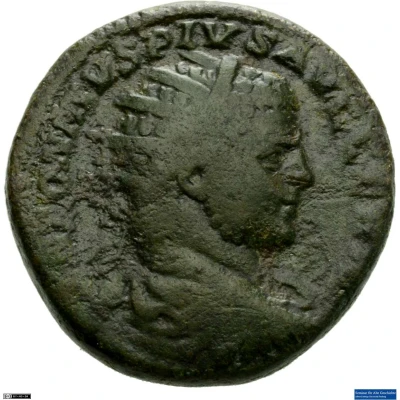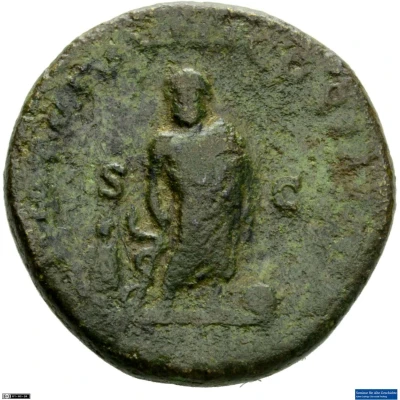


© Münzsammlung des Seminars für Alte Geschichte, Albert-Ludwigs-Universität Freiburg (CC BY-NC-SA 3.0 DE)
Dupondius - Caracalla P M TR P XVIII COS IIII P P S C; Asclepius and Telesphorus
215 year| Bronze | 11.4 g | 24 mm |
| Issuer | Rome › Roman Empire (27 BC - 395 AD) |
|---|---|
| Emperor | Caracalla (Marcus Aurelius Antoninus Caracalla) (198-217) |
| Type | Standard circulation coin |
| Year | 215 |
| Value | Dupondius (1⁄16) |
| Currency | Antoninianus, Reform of Caracalla (AD 215 – 301) |
| Composition | Bronze |
| Weight | 11.4 g |
| Diameter | 24 mm |
| Shape | Round (irregular) |
| Technique | Hammered |
| Demonetized | Yes |
| Updated | 2024-10-05 |
| Numista | N#273949 |
|---|---|
| Rarity index | 97% |
Reverse
Asclepius, nude to waist, standing front, head left, holding serpent-wreathed wand in right hand; to left, Telesphorus; on ground, right, globe.
Script: Latin
Lettering: P M TR P XVIII COS IIII P P S C
Translation:
Pontifex Maximus, Tribunicia Potestate Octava Decima, Consul Quartum, Pater Patriae. Senatus Consultum.
High priest, holder of tribunician power for the 18th time, consul for the fourth time, father of the nation. Decree of the senate.
Comment
Example of this type:Münzsammlung des Seminars für Alte Geschichte, Albert-Ludwigs-Universität Freiburg
Source:
Online Coins of the Roman Empire (OCRE)
Interesting fact
The Dupondius - Caracalla coin features the image of Asclepius, the Greek god of medicine, on one side, and Telesphorus, the mythical founder of the city of Rome, on the other. This coin was minted during the reign of Emperor Caracalla, who was known for his extensive military campaigns and his attempts to increase the Roman Empire's territorial reach. Despite its age, this coin remains a popular collector's item among numismatists and historians due to its rich historical significance and the insights it provides into the cultural and religious beliefs of ancient Rome.